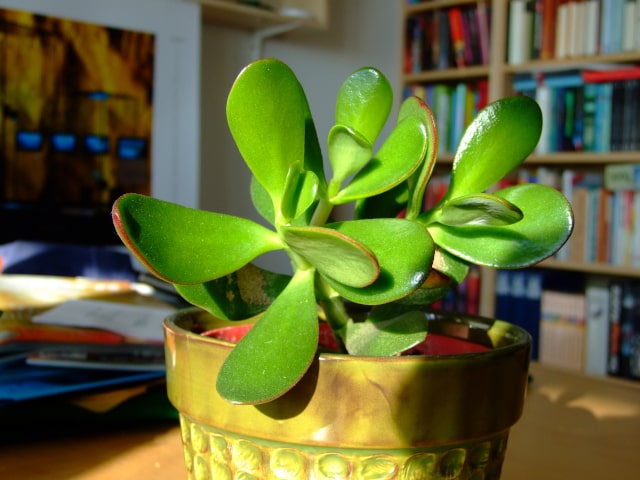
Jade plants are beautiful and you can grow them in your home. However, these plants often develop certain problems. Pests are one of them, but there's more. In order to make your jade plant as beautiful as it can be it's important to know how to address and treat some common problems with your jade plant.
Lack of Flowers
Many people get a bit disappointed when they realize their jade plant is not flowering. Fear not: it's not about you. This is how jade plants are. They flower very rarely. Flowering is usually a sign of plant age. Jade plants flower when they are about 5 to 8 years old. This is why many gardeners have to wait for a long time to see it bloom.
More importantly, indoor plants never bloom, so you need to be ready for this if you keep your jade plant indoors. From time to time, a young plant might bloom but it's uncommon.
What to do? There's nothing you can do about it. It doesn't mean anything is wrong about your jade plant; it's normal for it not to flower.
Loss of Leaves
You may notice that your jade plant is losing leaves or that its leaves are dropping off. Combined with underdeveloped leaves and leggy growth, this may be a sign of inadequate lighting. Move your jade plant to a place with better lighting. If necessary, supply it with artificial light. You need to meet the plant's requirements for lighting so it can thrive.
Yellowing In Mass
What if leaves are yellowing in mass? This can happen often with overwatering. If you notice some rotting, it's a clear sign you should reduce watering levels. In case the plant continues to decline even after you have cut the watering, check its root system. In case roots are healthy and white, repot the plant in fresh soil. However, if roots are rotted, the only thing you can do is to start a new plant by propagation from leaves. Pick a strong, healthy leaf to propagate your new jade plant.
Dropping Older Leaves
If your jade plant drops older leaves it might be a sign of too much heat, especially if you notice some other warning sounds such as soft, leggy growth. To help your plant, move it to an area with more air movement and lower temperatures. In winter, make sure not to place your jade plant near a heating source, because the heat might cause the problems described above.
Other Issues
Here are some other common symptoms and conditions jade plants can get.
A black mold coating on the leaves is a sign that there is too much humidity. You can wipe the mold away with soapy water. Don't forget to move the plant in an area with more light and less humidity.
If the top of the soil develops a white or gray covering it's also mold. This one results either from over-watering or too much fertilizer. Remove the mold from the surface and adjust watering and fertilizing to reach the plant's optimal levels.
Generally speaking, jade plants are not prone to pests. The only relatively common pest is mealy bug, but it can be controlled with a wide range of products and methods.
Photo credit: only_point_five
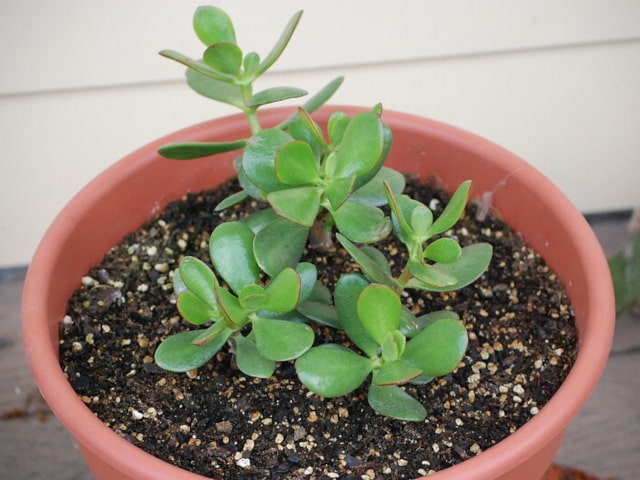
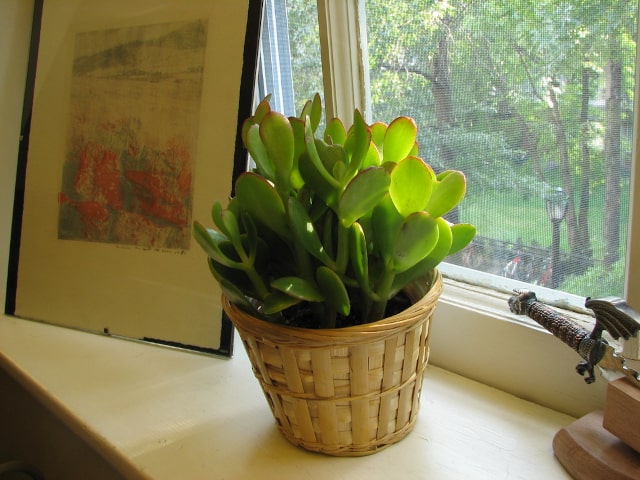
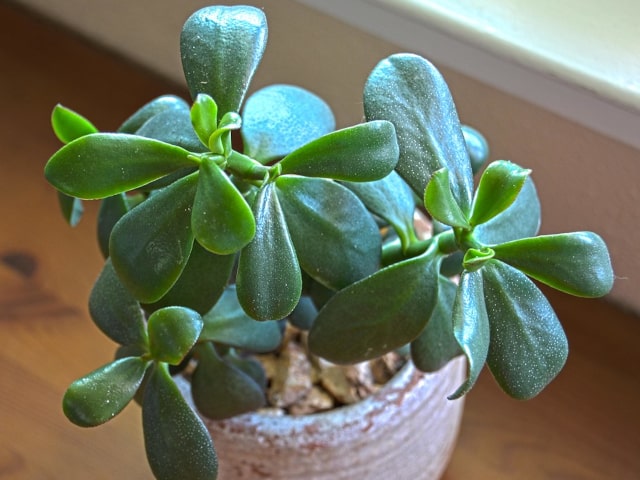
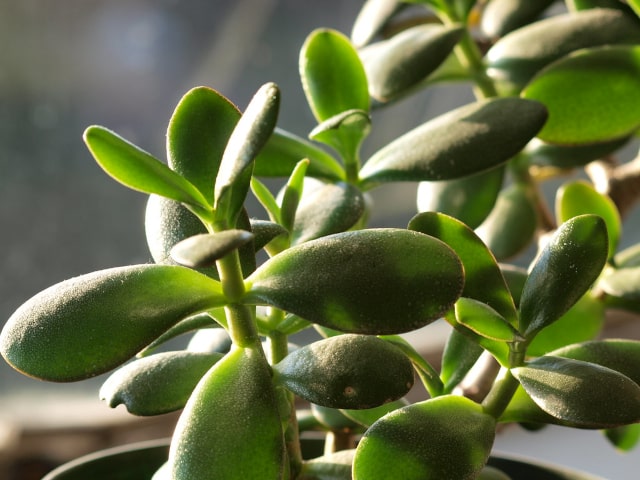
27 Comments
My plant is quite old and has been neglected the past few years as it's caretaker (Grandma) aged… I'm trying to nurse it back to health but keep having whole branch sections of fairly new growth fall off. Upon further inspection the main branches are hollowed out and often have a green moldy look to them on the interior. I need help and can't find it anywhere
My Jade plant has two leaves that are yellow. What is she saying to me?
I inherited a beautiful 30yo jade. This is my first year with her. There are many leaves dropping and occasionally some branch that seems to be hollow and dry. Any ideas? Is this normal winter shed? HELP!
My Jade is about 30 years old, goes outside early May comes back in late September. Blooms every year around Thanksgiving. This summer I have had a lot of leaves start to turn yellow on the tip of the leaves. Plant looks very healthy, maybe not as green as in the winter. It gets direct sun all afternoon, is in a clay pot in a whiskey barrel with soil around clay pot. I also cover it from heavy rain. What do you think?
Hi, My Jade plant has been loosing a lot of leaves and now the other day I found a brownish type thing growing out of the soil of my Jade plant. Kind of mushroom like but not. I have a picture but not sure if I can post it here. Any ideas of what is going on and what I can do about it. Thanks!!
My Jade plant has what looks like bites out of it they are gray or light brown and appear most often around the base of the plant. The leaves are green and well rounded not shriveled. Any ideas?
There is Jade all over the east and north facing banks outside (Southern California) and they are spreading all overt the place. Now the leaves have black, white, brown and yellow circles covering the leaves. It looks like rot or mold or a disease. When I cut a section off, the inside flesh of the stalk has brown gritty layers. I can't find ANY information on this condition. Help! I want to just rip it all out but there is opposition from other household members in doing this.
My 3 year old jade rubber tree plant is kept in a screened porch. Since winter months (in Florida ) the leaves are turning brown in middle and dropping off. Also, branches are dropping and soft. Can you help me?
My 3 Jades are now too large to bring in for the winter. They measure 7ft x 6ft each plant. I moved them into my shed to avoid frost this winter, 3 months on the leaf loss is dramatic. The compost is damp but I have not watered them for 3 months.
I have opened the shed door so as to allow more light to pass and to aerate the shed.
Any ideas on how to save my 40 year old plants would be most welcome.
My Trumpet Jade plant is about 30 years old. How long does a Jade plant live?
My Jade plant is dropping leaves, very fragile to touch. Some leaves have shrivelled but most are good healthy looking but dropping off. Its about 10 years old, not very big.
Hey, I brought a small Jade plant few days back and in a week's time it started dropping leaves and almost half the leaves have dropped till now although new smaller leaves are growing. And the top layer of the soil is also turning white. I am not able to understand what's wrong. I was water it only when the top soil is completely dry and also keep it in the balcony for some natural light too. Then where am I doing wrong?
A Jade plant in a "dish w/ other types of Jade & Cacti" is dying. Leaves brown (as in burned) tho not in direct sun.
How can I save it? Stalk still looks green (healthy) can I clip leaves & save original plant?
Hi there. I have a Jade plant. It was originally planted in my garden but when I noticed that a lot of the leaves got brown spots on top of the leaves I transplanted the Jade into a pot. I'm not sure what the brown spots are? I think it might be that snails got onto it or birds are pecking at the leaves. I have read that it might be because of over watering it? Not sure what the cause is. How do I get rid of the leaves? Can I just nip them off. I'm scared to do that because most of the leaves look like that and if I nip them off my tree might not have any leaves left.
My Crassula Gollum plant has, what looks like, white powdery mildew growing in patches. What can I do to stop this and make it go away?
My Jade plant is top heavy. I have staked it up but it still wants to fall over. The leaves are large and it is very healthy. What can I do?
My mum's Jade plant has developed this strange white, almost fluffy looking substance on it. But instead if it being fluffy it's actually sticky and seems to drip sticky liquid, very odd.
It's mainly all over the trunk and by the leave but there is some on the leaves too! Help!
My 40-year old Jade trees are breaking at the base. The stems seem healthy, but where they have broken I can see white fungus has plugged the xylem vessels. The fungus appears to have invaded through the roots. It is not powdery. When the plant has died, darkened, and shriveled, the white fungus then appears on the outside of the dead plant in discreet, hard, white clumps. This process has taken down about a ten-foot square area of old, large jade trees and spreads underground, I believe. Can you identify the culprit and tell me how to save the rest of my jade trees that come up everywhere in my rocky garden in Tiburon, CA?
Its likely mealy bugs as they leave a sticky residue behind. There are plenty of natural/non-natural pesticides you can purchase to rid your plant of them.
My 3 yr old jade has these weird bumps on some of the leaves that are under the leave skin. When I scratch the bumps you just see the interior of the leaf. It's hard to explain and I wish I could send you a photo. There's also some littler green discoloration and I'm not sure what it is. I've looked online and can't find any diseases that look like this. Any ideas?
My Jade plant is about 8 yrs old. It has a sticky substance over all the leaves. What do I do?
My Jade is healthy and green but the leaves it hasare down instead of up. it has new growth.
Hello. My Jade plant is fairly large and old. Recently one of the main branches looks like it is shrivelling up. It has two main branches and one has drooped over and all the branches are just hanging down. I don't give it lots of water and never fertilize it. Not sure what is wrong. I have had it for about 12 yrs. I'm in southern Ontario and keep it inside most of the time. Can you suggest anything. Thanks for your time.
Wendy